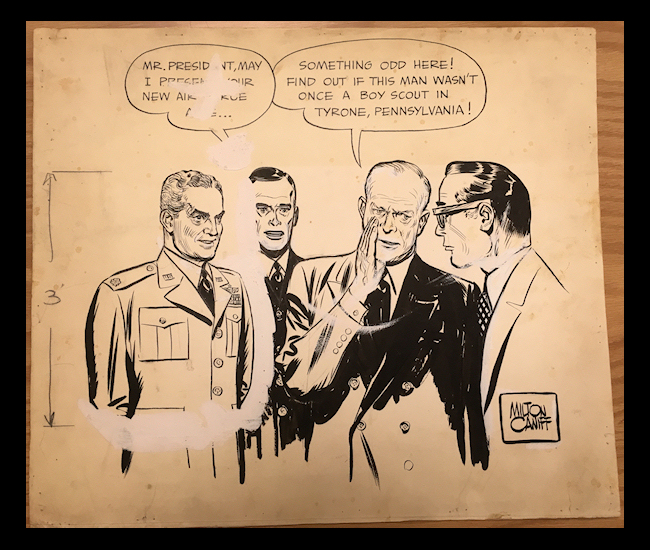

a note regarding
the Waring Collection
cartoons
shown in
‘a look at mj lorenzo’s second book Tales of Waring’
Except for a small number which will be
individually designated as exceptions when they appear, all of
the cartoons in the present work are part of Fred Waring’s
personal collection of cartoons accumulated over a lifetime as
personal gifts of friendship from their actual American
cartoonist authors. Waring then re-gifted and passed them on
by will upon his death in 1984 to his alma mater in
In November, 2018, the cartoons were
accessible to people not associated with PSU in any way (not
student, alumnus, administration, employee, or local town
person, etc.). Dr. Lorenzo therefore was able, in several
hours’ time, with the devoted help of quick-footed student
librarians, to photograph (using an iphone 6) dozens of
cartoons in the collection. Most were drawn or colored on
large sheets of paper and held in groups of ten or twenty per
folder, the folders organized roughly alphabetically. A few
were on cardboard, and at least one was painted on wood. The
backdrop the Dr. used for photographing was the wood grain
upper surface of a library table in the Special Collections
area.
Two of the cartoons (as will be
indicated, when they are shown) were actually painted and
glazed onto tabletops, and these entire tables had been given
Waring by the cartoonists (Goldberg and Devlin). For years
they were used on a daily basis at his Shawnee Inn and Golf
Course in
Dr. Lorenzo sent a pertinent memo to the editorial staff of the present work just before its publication, which reads in part:
I would like to point out that some of the cartoons are, in my opinion, significant works of art because of the psychological depth with which they address their recipient, Mr. Waring. Evaluation of their artistic worth in purely artistic terms I will leave to those more qualified, but it seems to me that a few are impressive in this respect too, even down to quoting or mimicking the great European art masters at times.
Also, I want to mention the impact that the
life stories of the cartoonists had on me personally. When I
went to the internet to read about individual cartoonists who
turned up in the more or less random selection of cartoons I
photographed, I was struck by the dedication and brilliant
talent of many. Whatever ill may be said of Waring, he
certainly had some stellar friends in the cartoonists, and
they seemed to love and respect him greatly, for the most
part. Many were men of character who served during World War
II, or if not by active military service, helped the war
effort by cartooning for the Army, Air Force, etc. Others
designed war- or service-related cartoon characters and
stories which became syndicated, either for daily and Sunday
newspapers around the country, or for branches of the
military. Some of Mr. Waring’s cartoonist friends have been
recognized and honored significantly by their hometowns, one,
for example (Milton Caniff – see cartoon below), being called
on a historical monument the ‘Rembrandt of Comics’.
I suspect that over time some of the cartoonists whom we took
for granted down through the twentieth century, when we threw
their comics pages in the trash without thinking, will be
recognized as having been significant contributors to, and
shapers of, American culture, education and art. Already there
has been a trend in the last few decades toward honoring them
more and more by expanding some of their work into movies or
television series of distinction (‘The Flash’ TV series, for
example, not to mention movies about Superman, Superwoman,
Wonder Woman, Spiderman, etc., etc.) Maybe Waring was ahead of
the rest of us in appreciating the brilliant personal and
artistic cleverness of the country’s cartoonists.

personal
gift (damaged) to Fred Waring from American cartoonist
Milton Caniff which says (a little cornily):
(
may I
present your new Air Force Aide...” (who is drawn to
look like Fred Waring)
(President
Eisenhower to second official:) “Something odd
here! Find out
if this man
wasn’t once a Boy Scout in
[1] This
(damaged) (and apparently ‘draft’, or trial) cartoon
might make more sense (now, in 2019) to some, if
Fred Waring had been controversially trying to talk
the United States president, Eisenhower, whom many
Americans knew to be his golfing, political and fun
time friend, into doing something questionable with
the U.S. Air Force. Then it would resemble a
political cartoon about suspected improper
influence. However, 65 years later, we are unaware
of any such publicly questioned attempt by Fred to
have improperly influenced his friend Ike; and most
of Caniff’s public cartoon output was not political,
but more properly stated, patriotic. Further, two of
the other three privately gifted Caniff cartoons
shown in the present work contain clearly private
messages. So, probably in this case too the meaning
was more private, arising from the same-age
friendship between Waring and Caniff, and the
several major interests they shared in common. Both
men assisted in the war effort during World War II,
Waring with patriotic concerts and a canteen for
servicemen in mid-town